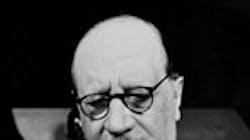Sven Wingquist
In 1905, a young maintenance engineer named Sven Wingquist worked at Gamlesstadens Fabriker, a textile plant on Sweden's west coast. The plant had a problem: Ball bearings used to support overhead line shafts (that transmitted power from the plant's central steam engine to rows of spinning machines) were constantly failing. So, Wingquist proposed to directors that the plant stop importing failing bearings, and manufacture their own out of better Swedish steel. Wingquist was given the green light to start the unusual bearing project, but only on his own time.
For an entire year, motivated Wingquist spent evenings and weekends on the project. At last, he presented a Swedish steel bearing to his superiors — with a new design that included a sphered outer race. Gamlesstadens leaders were pleased, and soon the entire plant was outfitted with the new bearings. The company even recognized potential for commercialization, and in 1907 opened the Svenska Kullagerfabriken (SKF) — Swedish Ball Bearing Manufacturer — to market Wingquist's design.
However, though it far outlasted previous units, Wingquist was not fully satisfied with the new bearing's durability: He noticed that during rains, the clay upon which the textile factory was built tended to soften, and allowed the buildings to settle slightly. This in turn caused the factory's line shafts to bend a few fractions of a millimeter, just enough to elevate bearing friction and premature fatigue. Wingquist wondered: Was it possible to diminish settling-induced misalignment between shafts and housings within the bearing itself?
In March 1907, after compulsive tinkering, heightened study of bearings, and immense research on the subject, Wingquist struck upon his now-famous idea: A self-aligning ball bearing that resolves axial loads within the bearing and includes a sphered outer-ring raceway. Its opposing sides' contact angles accomodate axial forces, so that even under misalignment, the bearings operate freely while carrying load. The design addressed the line shaft bearing problems, and several patents were awarded to Wingquist.
Wingquist proceeded to travel in Europe, calling on customers and setting up sales offices so that within a decade, largely due to his ingenuity and hard work, SKF had thriving factories worldwide. Wingquist then went on to become an independent consultant part-time CEO for SKF, and eventually the leader of two other corporations. SKF grew to become a global manufacturer of bearings.
For more information, visit SKF USA Inc. at skfusa.com.
